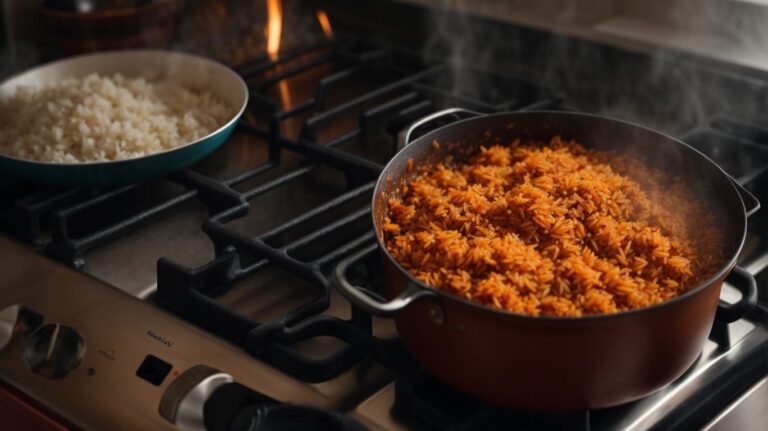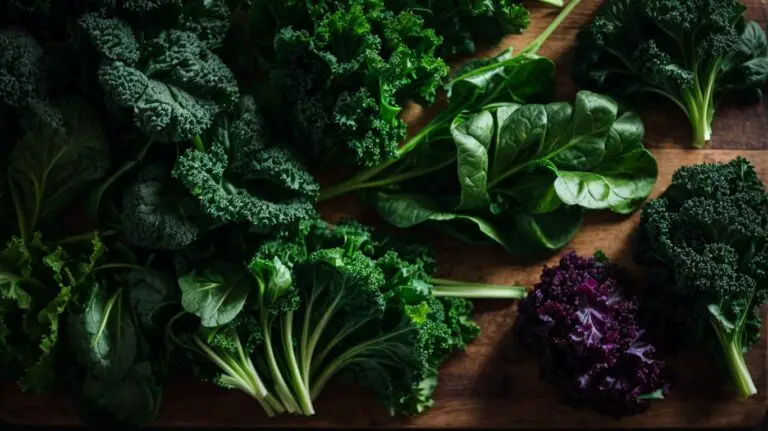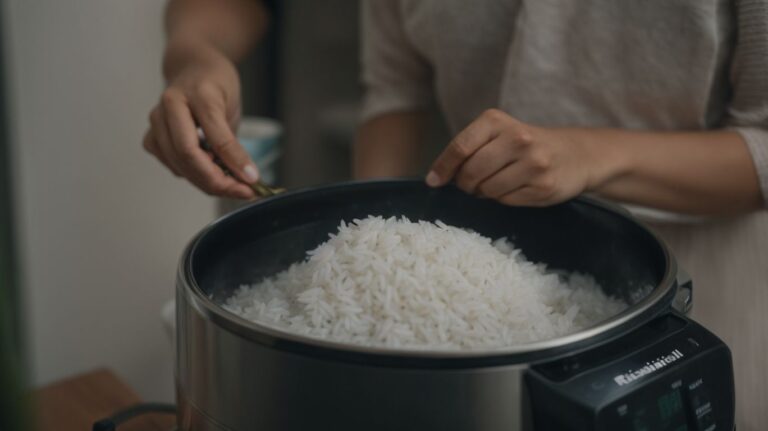How to Cook Lasagna?
.jpg)
Are you a fan of the classic Italian dish, lasagna, but unsure of how to make it at home?
We will explore everything you need to know about cooking the perfect lasagna. From the different types of lasagna to the essential ingredients and step-by-step instructions on how to prepare the noodles, make the meat sauce, assemble the layers, bake it to perfection, and serve it with the best side dishes.
Join us on a delicious culinary journey!
Key Takeaways:
What is Lasagna?
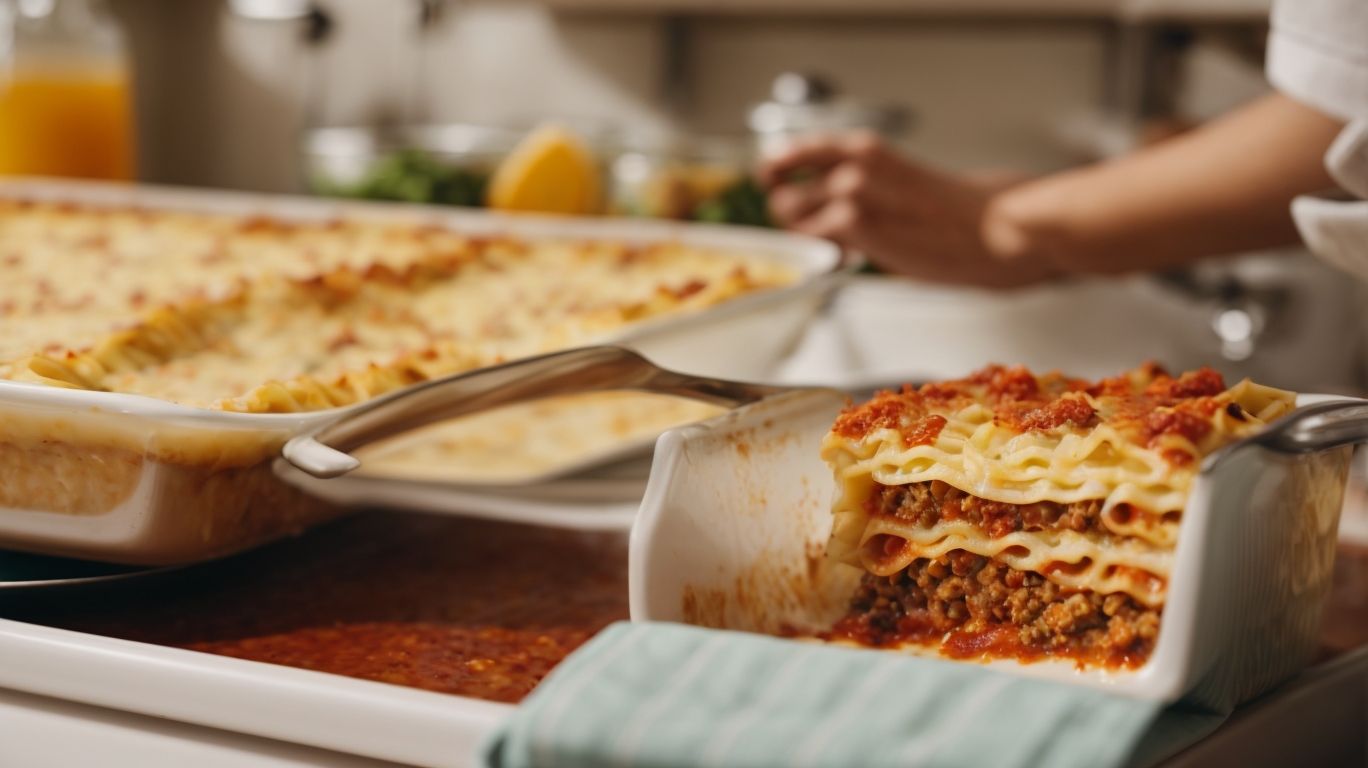
Credits: Poormet.Com – Scott Sanchez
Lasagna is a classic Italian dish known for its indulgent layers of pasta, rich tomato sauce, savory meat, creamy cheeses, and aromatic seasonings.
Lore suggests that lasagna has ancient Greek and Roman roots, evolving over the centuries into the delectable dish we enjoy today. The beauty of lasagna lies in its layers; each thin sheet of pasta absorbs the flavors of the sauce, meat, and cheese it envelops.
Cheese, particularly ricotta, mozzarella, and Parmesan, adds a creamy richness that binds the layers together, creating a harmonious blend of textures and tastes.
Each forkful delivers a symphony of flavors, making every bite an experience of comfort and satisfaction. It’s no wonder lasagna has found its way into various culinary traditions worldwide, each culture giving it a unique twist while staying true to its comforting essence.
What Are The Different Types of Lasagna?
There are various types of lasagna that cater to different preferences and dietary restrictions, including vegetarian lasagna, seafood lasagna, and gluten-free lasagna.
Vegetarian lasagna often features a medley of fresh vegetables such as zucchini, bell peppers, and spinach, layered between creamy ricotta and mozzarella cheese.
Seafood lasagna, on the other hand, combines delicate seafood like shrimp, crab, or scallops with a rich white sauce, providing a unique twist on the classic Italian dish.
Gluten-free lasagna uses alternative pasta sheets made from ingredients like rice flour or corn, ensuring a satisfying meal for those with gluten sensitivities.
Ingredients for Lasagna
The essential ingredients for lasagna include lasagna noodles, tomato sauce, ground beef, ricotta cheese, mozzarella cheese, and a blend of Italian herbs and spices.
Lasagna noodles form the foundation of the dish, providing structure and a satisfying chewiness between layers.
Tomato sauce serves as the savory base, infusing each bite with rich, tangy flavors.
Ground beef adds a hearty meaty element, offering a contrast in texture and taste.
Ricotta cheese contributes a creamy, indulgent layer that blends beautifully with other ingredients.
Mozzarella cheese melts to perfection, creating that irresistible gooey, cheesy topping.
Italian herbs and spices, like oregano and basil, bring a fragrant complexity that ties all flavors together.
Optional ingredients such as sautéed mushrooms, spinach, or bell peppers can elevate the dish with added depth and freshness.
Experimenting with different cheeses, like Parmesan or provolone, can enhance the complexity of flavors.
Consider adding a touch of nutmeg or red pepper flakes for a unique twist on traditional lasagna.
What Are The Essential Ingredients for Lasagna?
The essential ingredients for lasagna form the foundation of this delectable dish, providing the necessary components for its iconic taste and texture.
First and foremost, noodles serve as the backbone of lasagna, offering a sturdy base for the layers of flavors to come. The sauce, whether it be a rich marinara or creamy bechamel, brings a harmonious blend of tanginess and savory notes, binding everything together.
Next, the choice of meat plays a crucial role in defining the character of the dish. Whether opting for classic ground beef, flavorful sausage, or even a vegetarian alternative like lentils, the meat adds depth and richness.
Lastly, cheeses such as mozzarella, ricotta, and parmesan not only provide gooey, cheesy goodness but also contribute their distinct tang and nuttiness to create a symphony of flavors in every bite.
What Are The Optional Ingredients for Lasagna?
Optional ingredients for lasagna offer a creative twist to the traditional recipe, allowing for personalization and experimentation in flavors and textures.
Regarding enhancing the flavors of lasagna, consider adding a medley of colorful vegetables such as spinach, zucchini, bell peppers, or mushrooms. These veggies not only bring a burst of freshness but also provide additional nutrients to the dish.
If you are a fan of robust flavors, you can experiment with incorporating fresh basil, oregano, or thyme into the tomato sauce. These aromatic herbs will elevate the overall taste profile and lend a tantalizing aroma to your lasagna.
For those looking to switch up the protein component, try substituting the classic ground beef with Italian sausage, shredded chicken, or even plant-based alternatives like tofu or lentils. This variation can cater to different dietary preferences and add a unique twist to your lasagna creation.
Whether you prefer a classic lasagna or want to venture into uncharted culinary territory, these optional ingredients offer a world of possibilities to make this beloved dish truly your own.
How to Prepare the Lasagna Noodles?
Preparing lasagna noodles involves boiling them in salted water until al dente, then draining and rinsing them to halt the cooking process and prevent sticking.
For the best results, bring a large pot of water to a rolling boil and add a generous amount of salt to enhance the flavor of the noodles. Once the water is boiling, carefully add the lasagna noodles and stir occasionally to prevent them from sticking together. Cooking time may vary depending on the type of noodle you are using, so refer to the package instructions for guidance on the ideal cooking duration.
If you are using oven-ready lasagna noodles, you can skip the boiling step and layer them directly into your lasagna dish. These noodles will cook perfectly as the dish bakes in the oven, absorbing moisture from the sauce and other ingredients.
Alternatively, if you need gluten-free options, look for specialized lasagna noodles made from rice flour, corn, or quinoa. These noodles can be cooked in the same manner as traditional pasta but may require different cooking times, so be sure to monitor them closely to achieve the desired texture.
How to Make the Meat Sauce?
Crafting a flavorful meat sauce for lasagna begins with browning ground beef in a skillet, then simmering it with garlic, onions, tomato sauce, and herbs until a rich, savory sauce is achieved.
Once the ground beef is well-browned, adding a splash of red wine can add depth and complexity to the sauce. Let it simmer and reduce slowly to intensify the flavors.
For a vegetarian twist, substitute the ground beef with lentils or mushrooms for a hearty and flavorful alternative.
Alternatively, opt for a leaner version by using ground turkey instead of beef for a lighter option that still provides a delicious taste.
What Are The Best Types of Meat for Lasagna?
The best types of meat for lasagna include well-seasoned ground beef, Italian sausage, or a combination of both to add robust flavor and texture to the dish.
Well-seasoned ground beef is a classic choice, bringing a rich and savory taste to the lasagna. Its versatility allows it to pair well with various ingredients commonly found in lasagna, such as tomato sauce and cheese. Italian sausage, on the other hand, offers a more bold and spicy flavor profile, contributing complexity to the dish. Combining both meats can create a harmonious blend of flavors. To enhance the meat’s contribution, season it generously with herbs like oregano, basil, and garlic powder.
When cooking the meat, make sure to brown it evenly to develop a deep flavor and drain excess fat to prevent the lasagna from becoming greasy. Layer the meat sauce between the lasagna sheets and cheese to create a flavorful and satisfying dish that will surely impress your guests.
What Are The Steps to Make a Delicious Meat Sauce?
Creating a delicious meat sauce for lasagna involves sautéing aromatics, browning the meat, adding tomato sauce, and simmering the flavors together to achieve a savory and hearty sauce.
Once the aromatics like onions, garlic, and bell peppers are soft and fragrant, the seasoned ground meat is added to the pan to cook until browned. This crucial step helps develop rich flavors in the sauce. Next, a generous amount of tomato sauce is poured over the meat mixture, followed by a sprinkle of Italian seasoning and a pinch of sugar to balance the acidity.
The sauce is then left to simmer gently on low heat, allowing all the ingredients to meld together. Taste-testing is key at this stage, as you can adjust seasoning, salt, and pepper to your preference. For those inclined, a splash of red wine adds depth and complexity to the sauce, while fresh herbs like basil or oregano bring a burst of freshness.
How to Assemble the Lasagna?
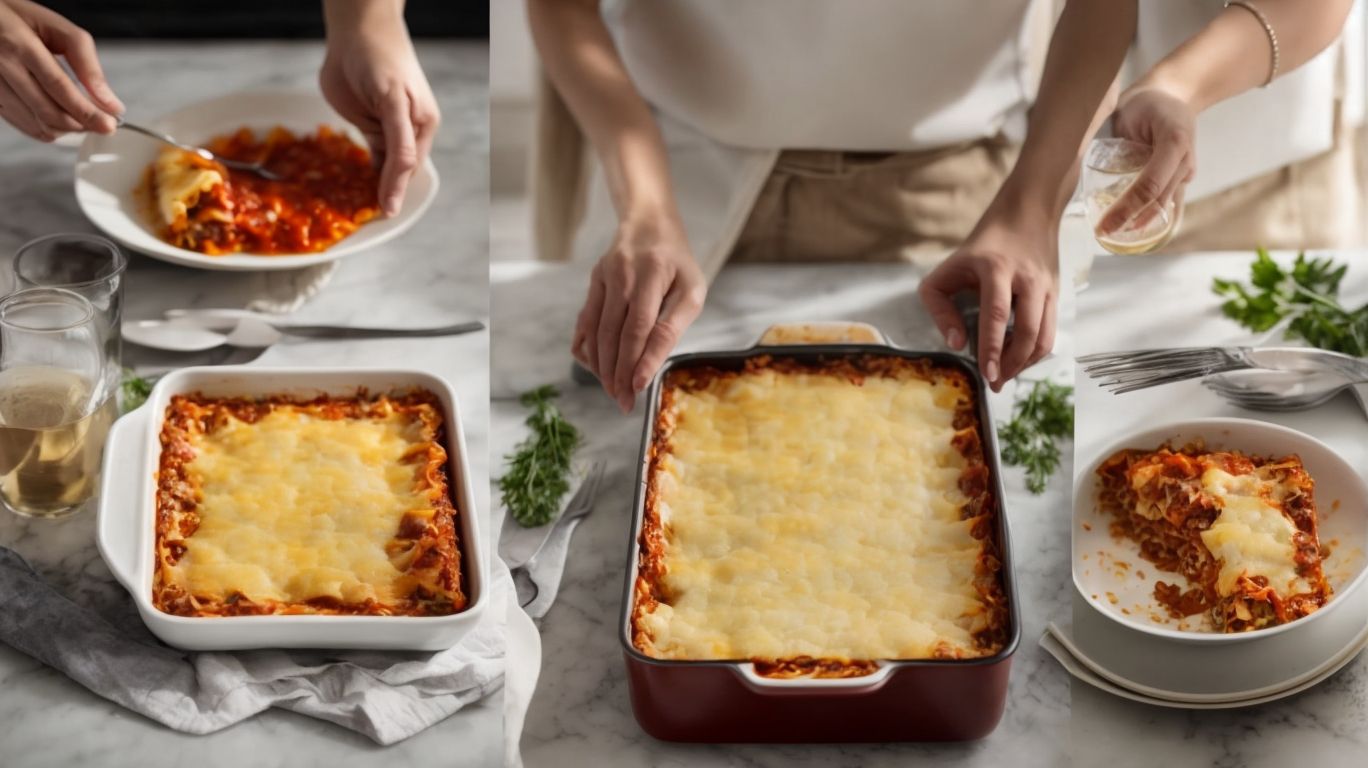
Credits: Poormet.Com – Brandon King
Assembling lasagna involves layering cooked noodles with meat sauce, cheeses, and additional ingredients in a casserole dish, creating alternating strata of flavors and textures.
For a delicious and well-structured lasagna, start by spreading a thin layer of meat sauce at the bottom of the dish. This helps prevent sticking and adds a savory base to the dish.
Next, lay a single layer of cooked lasagna noodles over the sauce, ensuring they slightly overlap. Then, add a generous layer of ricotta or bechamel sauce followed by a sprinkle of mozzarella and Parmesan cheese.
Repeat these layers to build up the lasagna, making sure to press down gently after each addition to create a cohesive and compact dish. Cover the top layer of noodles with a generous amount of sauce and cheese, ensuring complete coverage for even baking and a delightful cheesy crust.
What Are The Tips for Layering Lasagna?
Tips for layering lasagna include spreading a thin layer of sauce at the bottom of the dish, alternating noodles and fillings, and finishing with a generous topping of cheese for a golden crust.
When layering lasagna, it’s essential to ensure all ingredients are distributed evenly throughout each layer. This can be achieved by carefully spooning a portion of the sauce over the noodles and spreading it out with the back of the spoon.
- Paying attention to the sauce-to-noodle ratio is crucial. You want enough sauce to keep the dish moist but not too much to make it soggy.
- A well-layered lasagna should offer a delightful contrast of textures – tender noodles, flavorful fillings, and gooey melted cheese.
To create a visually appealing presentation, consider sprinkling some fresh herbs or grated parmesan on top before baking.
How to Bake Lasagna?
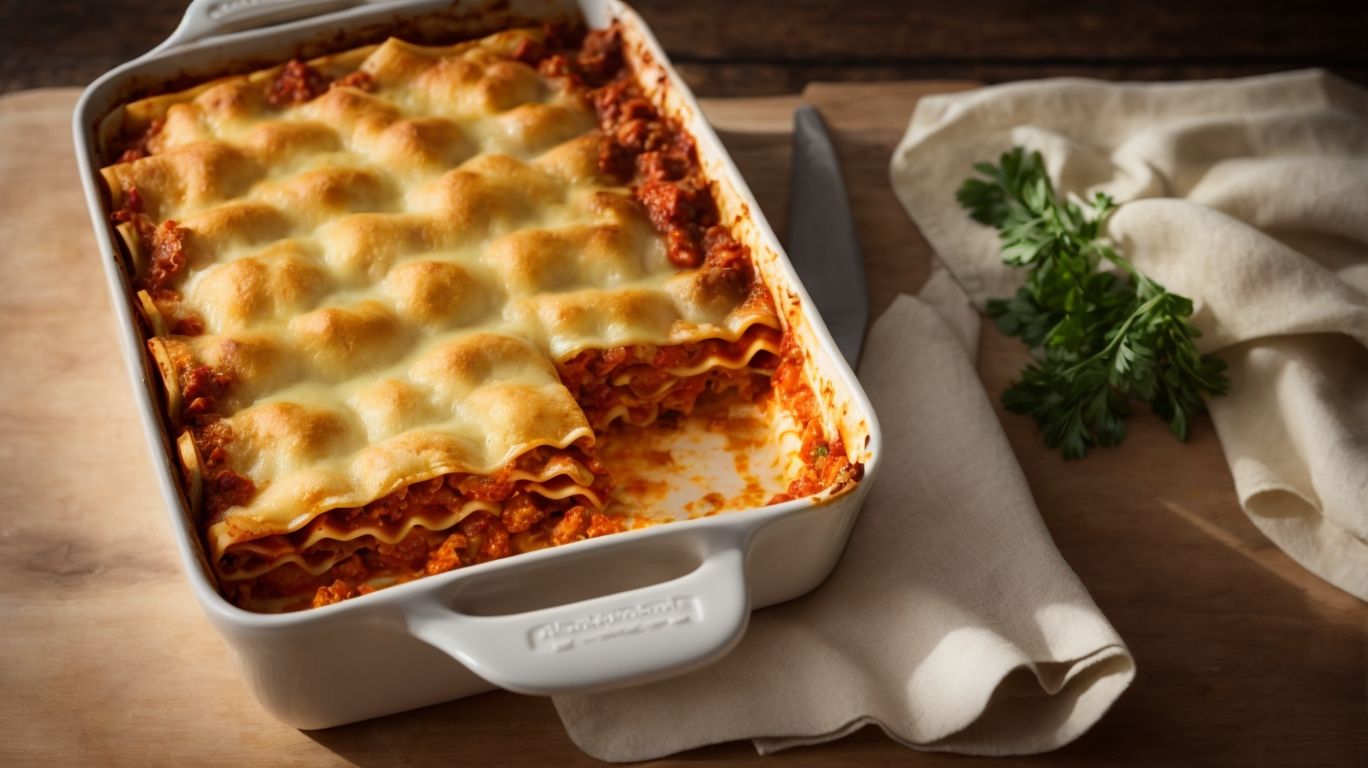
Credits: Poormet.Com – Roger Mitchell
Baking lasagna to perfection involves preheating the oven, covering the dish with foil to promote even cooking, then removing the covering to allow the cheese to brown and the edges to crisp.
Once your lasagna is assembled, preheat your oven to 375°F (190°C) for conventional ovens or 350°F (175°C) for convection ovens.
Place the covered dish in the center rack of the oven and let it bake for approximately 45-55 minutes for traditional noodles or 25-30 minutes for no-boil noodles.
To achieve a crispy top layer, uncover the lasagna in the last 10-15 minutes of cooking and broil on high for a few minutes until the surface is golden brown.
What Is the Ideal Temperature and Time for Baking Lasagna?
The ideal temperature and time for baking lasagna are typically 375°F (190°C) for 30-45 minutes, ensuring that the dish cooks through, the cheeses melt, and the flavors meld together.
Achieving that perfect golden crust can be a bit tricky. To ensure a well-cooked interior along with a crispy top, consider covering the lasagna with foil for the first 20-25 minutes and then removing it to allow the top to brown. This will prevent the top from burning while ensuring that the whole dish is cooked thoroughly. Different oven types may vary in cooking times, so it’s essential to keep an eye on the lasagna and adjust the baking time accordingly. If you’re using a larger or smaller baking dish than the recipe calls for, you may need to adjust the baking time to ensure that the lasagna is evenly cooked throughout.
How to Serve Lasagna?
Serving lasagna involves cutting portions with a sharp knife, lifting them carefully onto plates, and garnishing with fresh herbs or grated cheese for a finishing touch.
Once the lasagna has been baked to perfection, it’s time to bring it to the table for your guests. Start by using a sharp knife to cut clean and precise portions, ensuring each serving has all the delicious layers of pasta, sauce, and cheese. After cutting, delicately lift each piece onto the plates, making sure to maintain the layers intact for a beautiful presentation.
To enhance the visual appeal of the dish further, consider sprinkling some fresh basil leaves or parmesan cheese on top. The vibrant green of the herbs or the golden richness of the cheese can add a pop of color and flavor that will impress those at your table. Experiment with different garnishes to find the perfect combination that suits your taste and aesthetic preferences.
For a complete dining experience, serve the lasagna alongside a crisp green salad dressed with a light vinaigrette. The fresh greens and tangy dressing will balance out the richness of the lasagna, creating a well-rounded meal. A basket of warm, crusty bread on the table is always a welcome addition to soak up any leftover sauce.
What Are The Best Side Dishes to Serve with Lasagna?
The best side dishes to serve with lasagna include garlic bread, a crisp green salad, roasted vegetables, or a light soup to complement the richness of the main dish.
Garlic bread adds a delightful crunch and garlicky aroma that harmonizes with the savory layers of lasagna. Pairing it with a refreshing green salad offers a contrast of textures and flavors, providing a light and fresh element to the meal.
Roasted vegetables, such as bell peppers, zucchini, or eggplant, offer a heartiness and sweetness that complements the savory notes of the lasagna, enhancing the overall dining experience.
A light soup, such as a minestrone or tomato basil soup, serves as a comforting and warming addition to the meal, balancing out the richness of the lasagna with its broth-based goodness.
Frequently Asked Questions
What ingredients do I need to cook lasagna?
To make lasagna, you’ll need lasagna noodles, ground beef or Italian sausage, tomato sauce, ricotta cheese, shredded mozzarella cheese, eggs, and seasonings like garlic, oregano, and basil.
How do I layer lasagna?
Start by spreading a layer of tomato sauce on the bottom of your baking dish. Then, add a layer of cooked noodles, followed by a layer of the meat and cheese mixture. Repeat these layers until you reach the top of the dish, ending with a layer of sauce and cheese.
Can I make lasagna ahead of time?
Yes, lasagna can be made ahead of time and stored in the refrigerator for up to two days before baking. You can also freeze lasagna for up to three months before baking.
How do I know when lasagna is done baking?
The lasagna is typically done when the cheese is melted and bubbly and the noodles are tender. You can also insert a knife into the center of the lasagna and if it comes out clean, it’s done.
Can I substitute the meat in lasagna?
Yes, you can use other proteins like ground turkey, chicken, or even tofu in place of the meat in lasagna. You can also use vegetables like spinach or zucchini for a vegetarian option.
How do I store leftover lasagna?
Lasagna can be stored in the refrigerator for 3-4 days in an airtight container. To reheat, cover with foil and bake in the oven at 350 degrees Fahrenheit for 15-20 minutes, or until heated through.

